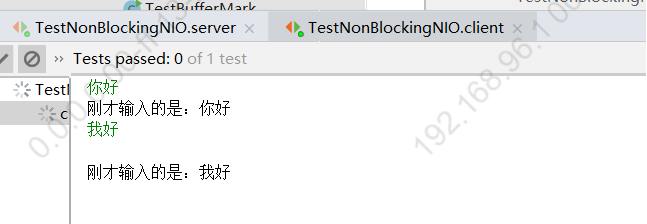非阻塞式NIO 小案例(模拟聊天室)
package com.nio;import org.junit.Test;import java.io.IOException;import java.net.InetSocketAddress;import java.nio.ByteBuffer;import java.nio.channels.*;import java.util.Date;import java.util.Iterator;import java.util.Scanner;/** * 一、使用NIO完成网络通信的三个核心 * 1.通道(Channel):负责连接 * java.nio.channels.Channel 接口 * |--SelectableChannel * |--SocketChannel * |--ServerSocketChannel * |--DatagramChannel * <p> * |--Pipe.SinkChannel * |--Pipe.SourceChannel * <p> * 2.缓存区(Buffer):负责数据的存取 * 3.选择器(Selector):是SelectableChannel 的多路复用器。用于监控SelectableChannel的IO状况 * <p> * 注意:在启动的时候,先启动服务端,再启动客户端 * <p> * 非阻塞式NIO 小案例 */public class TestNonBlockingNIO { @Test public void client() throws IOException { //1.获取通道 SocketChannel sChannel = SocketChannel.open(new InetSocketAddress("127.0.0.1", 9898)); //2.切换非阻塞模式 sChannel.configureBlocking(false); //3.分配指定大小的缓存区 ByteBuffer buf = ByteBuffer.allocate(1024); //4.发送数据给服务端 Scanner scan = new Scanner(System.in); while (scan.hasNext()) { String str = scan.next(); System.out.println("刚才输入的是:" + str); buf.put((new Date().toString() + "\n" + str).getBytes()); buf.flip(); sChannel.write(buf); buf.clear(); } //5.关闭通道 sChannel.close(); System.out.println("客户端启动成功"); } @Test public void server() throws IOException { //1.获取通道 ServerSocketChannel ssChannel = ServerSocketChannel.open(); //2.切换成非阻塞模式 ssChannel.configureBlocking(false); //3.绑定连接 ssChannel.bind(new InetSocketAddress(9898)); //4.获取选择器 Selector selector = Selector.open(); //5.将通道注册到选择器上 ,并且指定监听接收事件 ssChannel.register(selector, SelectionKey.OP_ACCEPT); //6.轮询式的获取选择器上已经准备就绪的事件 while (selector.select() > 0) { //7.获取当前选择器中所有注册的 选择键(已就绪的监听事件) Iterator<SelectionKey> it = selector.selectedKeys().iterator(); while (it.hasNext()) { //8.获取准备“就绪”的是事件 SelectionKey sk = it.next(); //9.判断具体是什么事件准备就绪 if (sk.isAcceptable()) { //10.若“接收就绪”,获取客户端连接 SocketChannel sChannel = ssChannel.accept(); //11.切换成非阻塞模式 sChannel.configureBlocking(false); //12、将该通道注册到选择器上 sChannel.register(selector, SelectionKey.OP_READ); } else if (sk.isReadable()) { //13.获取当前选择器上“读就绪”状态的通道 SocketChannel sChannel = (SocketChannel) sk.channel(); //14.读取数据 ByteBuffer buf = ByteBuffer.allocate(1024); int len = 0; while ((len = sChannel.read(buf)) > 0) buf.flip(); System.out.println(new String(buf.array(), 0, buf.limit())); buf.clear(); } } //15.取消选择键 SelectionKey it.remove(); } System.out.println("服务端启动成功"); }} |
然后分别启动服务端和客户端,启动成功之后,我们在客户端输入内容,发现服务端就能够成功接收到。


分类:
NIO





【推荐】国内首个AI IDE,深度理解中文开发场景,立即下载体验Trae
【推荐】编程新体验,更懂你的AI,立即体验豆包MarsCode编程助手
【推荐】抖音旗下AI助手豆包,你的智能百科全书,全免费不限次数
【推荐】轻量又高性能的 SSH 工具 IShell:AI 加持,快人一步
· 开发者必知的日志记录最佳实践
· SQL Server 2025 AI相关能力初探
· Linux系列:如何用 C#调用 C方法造成内存泄露
· AI与.NET技术实操系列(二):开始使用ML.NET
· 记一次.NET内存居高不下排查解决与启示
· 开源Multi-agent AI智能体框架aevatar.ai,欢迎大家贡献代码
· Manus重磅发布:全球首款通用AI代理技术深度解析与实战指南
· 被坑几百块钱后,我竟然真的恢复了删除的微信聊天记录!
· 没有Manus邀请码?试试免邀请码的MGX或者开源的OpenManus吧
· 园子的第一款AI主题卫衣上架——"HELLO! HOW CAN I ASSIST YOU TODAY
2020-02-20 (十四)MySQL语法-子查询(二)
2020-02-20 SQL语句复习--group by 的用法
2020-02-20 公司框架--增值税开票显示